Liturgical Year and Education Pastoral Plan 2021-2025
The Liturgical Year is also marked by special seasons—Advent, Christmas, Lent, The Triduum or Three Days, Easter, and Ordinary Time. The Liturgical Year begins on the first Sunday of Advent, which usually occurs around the beginning of December or the end of November, and ends on the feast of Christ the King.
However, the purpose of the Liturgical Year Calendar is not to mark the passage of time, but to celebrate and understand more fully the entire mystery of Jesus Christ, from his incarnation and birth until his ascension, the day of Pentecost, and the expectation of his return in glory. During the course of a year, the paschal mystery—the passion, death, resurrection, and ascension of Jesus—is viewed from different angles, in different lights.
The Liturgical Year Calendar first tells us what readings the Church has designated to be used for each day. Then it names the special feasts and commemorations celebrated during each season. These are listed one week at a time. A small colored cross reflects the color of the vestments to be worn by the priest during each celebration of the liturgy.
See also link Education Pastoral Plan 2021 – 2025
Education-Pastoral-Plan-2021-2025-Power-Point-presentation-(pdf)
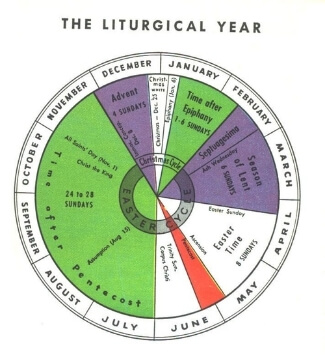
Liturgical Colors
White, the color of joy and victory, is used for the seasons of Easter and Christmas. It is also used for the feasts of Our Lord, for feasts of Mary, the angels, and for saints who are not martyrs. Gold may also be used on solemn occasions.
Red (the color of blood) is used on days when we celebrate the passion of Jesus on Passion Sunday and Good Friday. It is also used for the birthday feasts of the apostles and evangelists and for the celebrations of martyrs. Red (the color of fire) recalls the Holy Spirit and is used on Pentecost and for the sacrament of Confirmation.
Green, seen everywhere in plants and trees, symbolizes life and hope and is used during Ordinary Time.
The colors violet or purple in Advent help us to remember that we are preparing for the coming of Christ. Lent, the season of penance and renewal, also uses the colors violet or purple.
Rose may be used on the Third Sunday of Advent, Gaudete Sunday, and on the Fourth Sunday of Lent, Laetare Sunday. It expresses the joy of anticipation for Christmas and Easter, respectively.
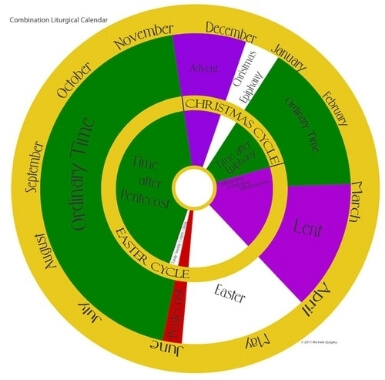
The Advent Season
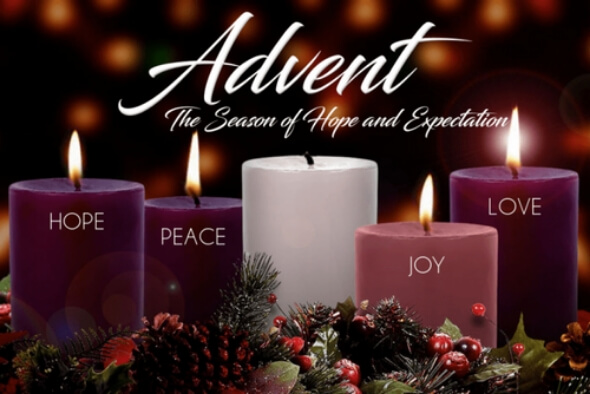
Remembering the First Coming of Jesus Christ, Looking Forward to the Second The term “advent” comes from the Latin adventus, meaning “coming” or “appearance.” Advent is the season marking the four Sundays before Christmas and developed as a way of helping Christians prepare not only to celebrate the birth of Jesus Christ in his First Coming but also to help them look forward to his glorious Second Coming. Although Advent customs may be foreign to many Latter-day Saints, we have found that, like so many seasonal traditions, they are a wonderful way to turn our attention more fully to the true meaning of Christmas.
Many Advent traditions come from Germany, where Martin Luther encouraged its continued observance as a way of teaching children and families more about the significance of the coming of Jesus Christ. It came to be celebrated by both Roman Catholics and Lutherans there and has become a common celebration in many Christian faith communities throughout the world.
One of the best known Advent customs is the lighting of the candles in an Advent wreath, a simple or decorated evergreen wreath with four candles placed in the circle and a single white candle in the center. The wreath itself represents the never-ending circle of God’s love, that he is the same and forever in his love towards his people. The green of the wreath, as in the Christmas tree, represents the hope of eternal life that comes through Christ and serves a reminder of the freshness of God’s love and promises. The light of the candles reminds us that Jesus is the Light of the World, that his birth represented the coming of the light into darkness, and that we are called to reflect that light in our lives.
The outer candles are purple, the color of royalty, although customarily the third one is rose or pink. Traditions differ regarding the symbolism of the candles. One is that they represent the hope, love, joy, and peace that come through Jesus Christ. Each Sunday before Christmas an additional candle is lit, creating a beautiful stepped-effect as the previous weeks’ candles burn down further. Scriptures can be read and carols sung as part of the lighting, which we do before family prayer. The four candles can also represent the different Old Testament covenants that God made with his servants, beginning with Noah and continuing through Abraham, Moses, and David. The central white candle is known as the Christ candle. It is lit on Christmas Eve and Christmas Day and represents the new covenant made possible through Christ.
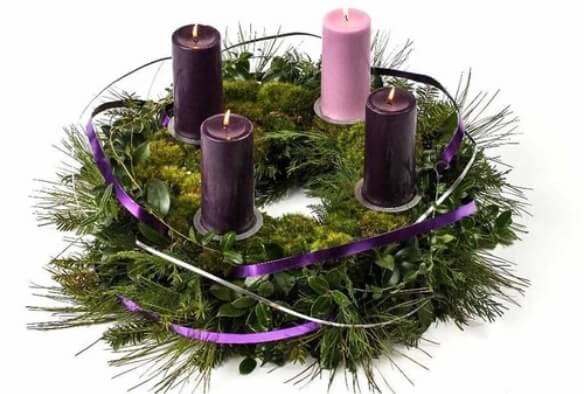
The Advent Wreath
The Advent wreath is a circular garland of evergreen branches representing eternity. On that wreath, five candles are typically arranged. During the season of Advent one candle on the wreath is lit each Sunday as a part of the Advent services. Each candle represents an aspect of the spiritual preparation for the coming of the Lord, Jesus Christ.
The Advent Wreath Candles
Set on the branches of the wreath are four candles: three purple candles and one pink candle. In the center of the wreath sits a white candle. As a whole, these candles represent the coming of the light of Christ into the world.
On the first Sunday of Advent, the first purple candle is lit. This candle is typically called the “Prophecy Candle” in remembrance of the prophets, primarily Isaiah, who foretold the birth of Christ. This candle represents hope or expectation in anticipation of the coming Messiah. Each week on Sunday, an additional candle is lit.
On the second Sunday of Advent, the second purple candle is lit. This candle typically represents love. Some traditions call this the “Bethlehem Candle,” symbolizing Christ’s manger.
On the third Sunday of Advent the pink, or rose-colored candle is lit. This pink candle is customarily called the “Shepherds Candle” and it represents joy.
The fourth and last purple candle, oftentimes called the “Angels Candle,” represents peace and is lit on the fourth Sunday of Advent. On Christmas Eve, the white center candle is traditionally lit. This candle is called the “Christ Candle” and represents the life of Christ that has come into the world. The color white represents purity. Christ is the sinless, spotless, pure Savior. Also, those who receive Christ as Savior are washed of their sins and made whiter than snow.
Celebrating with an Advent wreath during the weeks prior to Christmas is a great way for Christian families to keep Christ at the center of Christmas, and for parents to teach their children the true meaning of Christmas. In preparing for the death of our Lord Jesus Christ we enter the Lenten period.

What is Lent?
The season of Lent begins 40 days prior to Easter. (Sundays are not included in the count.)
Lent is a time when many Christians prepare for Easter. It is one of the major liturgical seasons of the Catholic Church. It is a penitential season marked by prayer, fasting and abstinence and almsgiving. Lent begins on Ash Wednesday. During Lent, we get a few changes in the mass. The priest wears purple vestments, to signify repentance; and we omit the Gloria (or Glory to God) in the first part of the Mass. We also quit singing the Alleluia before the reading of the Gospel.
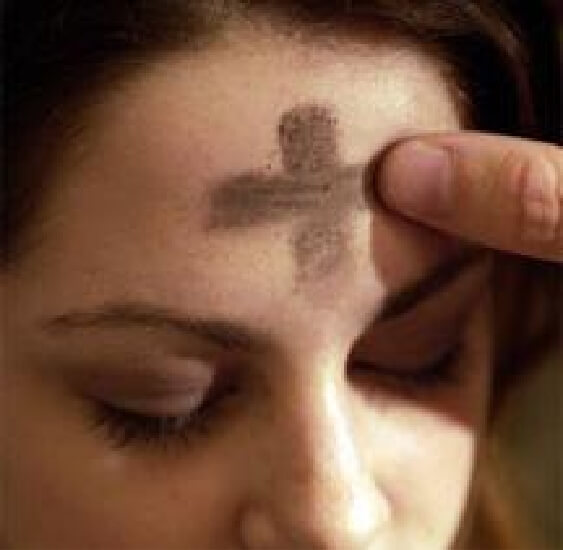
Ash Wednesday?
The Distribution of Ashes:
During Mass, the ashes which give Ash Wednesday its name are distributed. The ashes are made by burning the blessed palms that were distributed the previous year on Palm Sunday. After the priest blesses the ashes and sprinkles them with holy water, the faithful come forward to receive them. The priest dips his right thumb in the ashes and, making the Sign of the Cross on each person’s forehead, says, “Remember, man, that thou art dust, and to dust thou shall return” or “Repent and believe the Gospel”(or a variation on those words).
Explanation of the ashes: The distribution of ashes reminds us of our own mortality and calls us to repentance. In the early Church, Ash Wednesday was the day on which those who had sinned, and who wished to be readmitted to the Church, would begin their public penance. The ashes that we receive are a reminder of our own sinfulness, and many Catholics leave them on their foreheads all day as a sign of humility.
Fasting and Abstinence Are Required:
The Church emphasizes the penitential nature of Ash Wednesday by calling us to fast and abstain from meat. Catholics who are over the age of 18 and under the age of 60 are required to fast, which means that they can eat only one complete meal and two smaller ones during the day, with no food in between.
Taking Stock of Our Spiritual Life:
This fasting and abstinence is not simply a form of penance, however; it is also a call for us to take stock of our spiritual lives. As Lent begins, we should set specific spiritual goals we would like to reach before Easter and decide how we will pursue them—for instance, by going to daily Mass when we can and receiving the Sacrament of Confession more often.
Stations of the Cross
For Roman Catholics throughout the world, the Stations of the Cross are synonymous with Lent, Holy Week and, especially, Good Friday. This devotion is also known as the “Way of the Cross”, the “Via Crucis”, and the “Via Dolorosa.” It commemorates 14 key events on the day of Christ’s crucifixion. The majority concern His final walk through the streets of Jerusalem, carrying the Cross. The object of the Stations is to help the faithful to make in spirit, as it were, a pilgrimage to the chief scenes of Christ’s sufferings and death, and this has become one of the most popular of Catholic devotions. It is carried out by passing from Station to Station, with certain prayers at each and devout meditation on the various incidents in turn.

